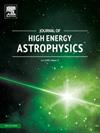2024年Aql X-1爆发探测热核爆发及x射线反射特征
IF 10.5
4区 物理与天体物理
Q1 ASTRONOMY & ASTROPHYSICS
引用次数: 0
摘要
我们报告了中子星低质量x射线双星Aql X-1在2024年爆发期间的宽带时序和光谱特性。在NICER和NuSTAR观测期间,我们检测到6个热核x射线爆发,观测到的x射线爆发剖面显示出强烈的能量依赖性。时间分辨爆发谱表明在爆发过程中存在软过剩,可以用可变持久发射法(fa法)或relxillNS反射模型来模拟。我们发现,在NICER爆发期间观测到的反射模式可以贡献约20%的总发射。在爆发期间观察到,反射和黑体分量通量是强相关的。由于Poynting-Rodertson阻力增加了中子星的质量吸积率,因此可能会有过量的发射,并且一小部分爆发发射可能从圆盘反射。这些爆发在峰值期间没有显示出光球半径的膨胀。此外,我们还利用NuSTAR、NICER和Swift在爆发的两个时期对宽带范围内的无爆发吸积发射进行了检测。持续发射表现出x射线反射特征,可以用相对论反射模型relxillCp很好地模拟。两次观测发现,内盘半径(Rin)分别接近Rg的22倍和10倍。假设内盘在磁层半径处被截断,则中子星两极的磁场强度估计为(0.6−1.9)×109 G。本文章由计算机程序翻译,如有差异,请以英文原文为准。
Probing thermonuclear bursts and X-ray reflection features in Aql X-1 during 2024 outburst
We report the broadband timing and spectral properties of the neutron star low-mass X-ray binary Aql X-1 during the 2024 outburst with NICER, NuSTAR, and Swift observatories. We detected six thermonuclear X-ray bursts during the NICER and NuSTAR observations, with the observed X-ray burst profiles exhibiting a strong energy dependence. The time-resolved burst spectra indicate the presence of soft excess during the burst, which can be modeled by using a variable persistent emission method ( method) or the relxillNS reflection model. We found that the reflection model can contribute ∼20% of total emission as observed during the NICER burst. The reflection and blackbody component fluxes are strongly correlated, as observed during a burst. The excess emission is possible due to the enhanced mass accretion rate to the neutron star due to the Poynting-Rodertson drag, and a fraction of burst emission may be reflected from the disk. The bursts did not show photospheric radius expansion during the peak. Moreover, we examined the burst-free accretion emission in the broadband range with NuSTAR, NICER, and Swift at two epochs of the outburst. The persistent emission showed X-ray reflection features, which can be well modeled with the relativistic reflection model relxillCp. The inner disk radius (R) is found to be nearly 22 and 10 times for two observations, respectively. Assuming that the inner disk is truncated at the magnetospheric radius, the magnetic field strength at the poles of the neutron star is estimated to be G.
求助全文
通过发布文献求助,成功后即可免费获取论文全文。
去求助
来源期刊

Journal of High Energy Astrophysics
Earth and Planetary Sciences-Space and Planetary Science
CiteScore
9.70
自引率
5.30%
发文量
38
审稿时长
65 days
期刊介绍:
The journal welcomes manuscripts on theoretical models, simulations, and observations of highly energetic astrophysical objects both in our Galaxy and beyond. Among those, black holes at all scales, neutron stars, pulsars and their nebula, binaries, novae and supernovae, their remnants, active galaxies, and clusters are just a few examples. The journal will consider research across the whole electromagnetic spectrum, as well as research using various messengers, such as gravitational waves or neutrinos. Effects of high-energy phenomena on cosmology and star-formation, results from dedicated surveys expanding the knowledge of extreme environments, and astrophysical implications of dark matter are also welcomed topics.
 求助内容:
求助内容: 应助结果提醒方式:
应助结果提醒方式:


